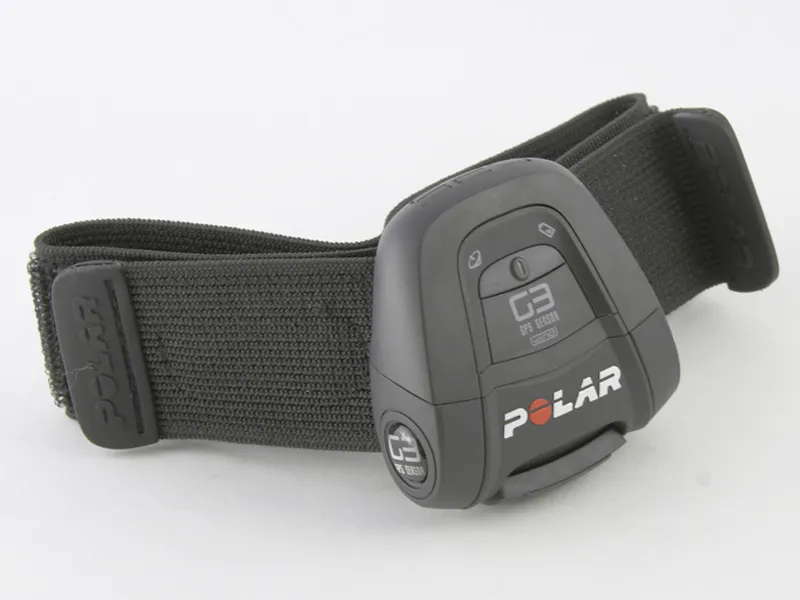Polar makes some bike-specific sacrifices to gain multi-sport versatility on its new RS800G3 Training System. Instead of the frame-mounted speed and cadence sensors used on the company's dedicated bike units, the RS800G3 gathers its speed and distance information via a separate GPS unit that can worn around the user's upper arm or clipped on to something like the strap of your hydration pack.
The novel configuration enhances the range of activities that can be recorded outside of the two-wheeled realm. During our test period, we used the RS800G3 on the bike as usual but also while running (er, more like 'wogging') and snowboarding, the latter of which was further enhanced by the elevation data provided by the wrist unit's barometric altimeter.
The wrist unit is rated as water resistant to a depth of 50m and the G3 sensor to 20m so paddlers should be able to join in the fun, too. According to Polar PR man Nick Sowards, the RS800G3 is also okay in the pool (just don't push the buttons underwater) although the realities of the water resistance rating system means that swimmers should use the unit at their own risk. Runners can also add the optional s3 stride sensor.
While the enhanced versatility was nice to have on some occasions, heavily bike-centric users will likely find that Polar has made a few too many sacrifices in order to get there. For one, the G3 unit is rather bulky and heavy (113g with the strap), plus having it fixed around your arm gets a bit old as the miles pile on. Moreover, the wrist unit isn't compatible with Polar's other wireless devices such as the WIND power meter or frame-mounted speed and cadence sensors.
More disappointing, though, is the fact that route information can't be downloaded after your workout and the RS800G3 offers no navigational functionality whatsoever. Raw GPS data can be used to tell you where you are, where you were and even how to get where you want to go, but the RS800G3 offers none of these things. Even if it could, though, the wrist unit's LCD display would probably be too small for the information to be of much use.
As a standalone heart rate monitor, the RS800G3 is hard to fault. Polar includes the usual über-comprehensive array of HRM functions and the included ProTrainer 5 analytical software is easy to navigate, although somewhat tedious to install. It's also chock-full of functions to aid the serious athlete, including the ability to preload planned workouts and upload them to the wrist unit to guide your workout for the day. Think of it as a sort of electronic coach that constantly reminds you if you're slacking on your training regime.
Hardware-wise, the wrist unit is well-designed with a more fashionable look than in years past and a comfortable fit. Navigating through the various screens is easy enough but the buttons are a bit small and hard to push. Barring the aforementioned GPS navigation shortcomings, the reasonably spacious screen is easy to view at a glance and displays information in a variety of user-selectable configurations. The infrared port used for downloading information is a oddly placed, though, and careful positioning was required to link up with the included IrDA USB adapter.

The included WearLink heart rate monitor strap's fabric construction is shockingly comfortable as compared to the usual giant-strip-of-plastic that we're accustomed to slapping across our chests. Unlike those lesser versions that would occasionally chafe and irritate, this one was as close to unnoticeable on your body as we've experienced, less likely to slide around, and seemed to more readily pick up ECG signals, too (no spit required!). Female users will also be happy to know that the small transmitter bit itself, which measures just 6cm (2.5") across, can be clipped directly to compatible sports bras, thereby eliminating the strap altogether.
Worth the compromises?
The overall concept makes sense but the drawbacks weigh heavily. In our eyes, the ideal configuration would be a wrist unit that is compatible with all of Polar's existing wireless bike sensors and the GPS unit, meaning you could wear the G3 when you need to but not when you don't. If Polar could do that (they're apparently working on it), downsize the sensor and add the route recording feature we'd probably be breaking down the doors to get one.
As it is, the usefulness and liveability of Polar's RS800G3 will depend heavily on your particular portfolio of activities. Multi-sport users may be able to overlook its shortcomings in exchange for having speed, distance and HRM information all the time but those who primarily spend their hours on the bike will probably be better served with something else.



